Weekly Blog 10
In my initial expectations, I had hoped to take what I learn from this course and apply it to the real world and hopefully benefit from it. I can say that I have definitely done that. Just yesterday I was in a situation where I was provoked by another person’s angry response, and rather than reacting aggresively I thought about non violent things and considered the reasons why they might be upset. I did this basing it off of our textbook’s recommended strategies for aggression, as well as the fundamental attribution error. We learned that it occurs when we falsely atrribute someone elses actions to their character, and not their situation (Baron & Branscombe, 2017). Using this, I remembered all the difficulties this person was experiencing and deciding not to get angry at them. I had also hoped to effectively manage my time, which I have struggled with but have so far been able to do.
I have achieved many of the course objectives. I already new the scientific methodology and the reasoning behind discrimination, but I definitely learned about influencing others opinions of us, whether they like us or not. I also learned about our attitudes and how they can be persuaded via different techniques (Baron & Branscombe, 2017). I have somewhat changed my attitude on social psychology. At first, I expected an intricite dive into the relationship between other human beings in a conversation or social setting, involving brain activation and whatnot. There is definitely a component of that, but I was surprised to learn how broad of a topic social psychology really is. Social situations are most of the situations that we find ourselves in every day, and I was surprised at the breadth of topics covered because of it.
If I were to do anything differently, I would change my initial approach to the class and relax. I attempted to storm through everything as fast as possible to manage my time for my other classes. I thought the class was more intense than it was. I think I could have enjoyed myself and gotten more absorbed in the material if I slowed down and let myself relax while reading and taking notes.
I would say that academically, I have fallen into a more effective and relaxed routine than I had earlier. I used to dread the next week and its new projects or challenges. Over time in this semester, I have come to understand and better prepare for my classes. This has allowed me to stay consistent and do well.
One essential skill I have gained from this course is one that I discussed earlier (technically two). In a dangerous situation, I was able to understand that the reason this person was angry was due to outside factors, and I was able to control my own emotions. Both of these abilities come from my studying on self regulation, aggression, and attribution errors (Baron & Branscombe, 2017). The ability to look at a situation from the other person’s perspective, and two regulate my own emotions and behavior, are incredibly beneficial.

I chose this image of a tool kit because to me, it represents how I have benefitted from this course. I now have a body of knowledge, or “tools” that I can draw from in different social situations to better handle them. I understand more about how and why others and myself will react to different things, our thought processes, and how power dynamics can impact different situations.
References
Baron, R. A., & Branscombe, N. R. (2017). Social psychology (14th ed.). Pearson.
Weekly Blog 9
The most interesting topic I have learned about so far in this course have been the heuristics. Heuristics are methods that the brain uses to rapidly process information and make decisions (Baron & Branscombe, 2017). What I found interesting was not only that these methods are employed even in rather serious situations, but also that with knowledge of them, they can be manipulated (Baron & Branscombe, 2017). Another interesting topic are some of the fallacies that we covered, my favorite being the fundamental attribution error. This error is a decision made in the mind to judge the actions of others by attributing them to the person’s character, rather than their circumstances, whereas we judge our own actions by our circumstances (Baron & Branscombe, 2017). I find this very interesting and it explains why people can fundamentally misunderstand one another. A final favorite topic is cognitive dissonance. This is when a person’s actions do not line up with their attitude on something, and involves a mental process of excusing this discrepancy (Baron & Branscombe, 2017). I chose this one because the activities related to it involved making me aware of my own cognitive dissonance, which I found fun and thought provoking.
In my weekly blog 7, I wrote about how self regulation and emotional intelligence are extremely important. They measure an individuals ability to control their own behavior, and be aware of their own emotions and why they feel the way that they do (Baron & Branscombe, 2017). This connects to our assignment 3, where I wrote about how Michael Richard failed to control his own emotions and lashed out. He likely had little control over his emotions, which is a part of self regulation (Baron & Branscombe, 2017).
One topic that has connected to another course is schemas. Schemas are mental frameworks or ideas we have of what something should be like based on past experiences (Baron & Branscombe, 2017). I found this to corrolate to adolescent psychology, where we discussed gender schema theory. This theory explains differences between boys and girls as children by claiming that they form schemas based on their observation of adults, shows, books, etc around them (Santrock, 2019).

This picture is my process for choosing my favorite topics I learned from the semester. I remembered various topics I found to be the most interesting, and referenced my notebook and the textbook to make sure it was accurate. As you might be able to tell from the picture, it was somewhat chaotic, with many tabs open and a notebook as well.
References
Baron, R. A., & Branscombe, N. R. (2017). Social psychology (14th ed.). Pearson.
Santrock, J. W. (2019). Adolescence (17th ed.). Mcgraw-Hill Education.
Weekly Blog 8
In reading this article, I felt that it was interesting, but since it didn’t match my personal experiences, it didn’t resonate as strongly with me. I found it to align with our textbook on the ways that women and men differ in mating preferences. I also found it unsettling to know that both men and women manipulate their partners: many men lie to get to sex, and women are more likely to use sex to get material resources. I found I could relate it to my love score assignment from before, where I was surprised that my desire not to manipulate a romantic partner was more than most of the population.
I have much more experience in the ways that women upset men, but I can also share some experiences of the opposite. In general, women have upset men that I know because they tend to hide their intentions or motivations, leaving the man feeling confused and angry at their behavior. This includes things like cheating, leading a person on, or acting (to the man) in a bizarre way, with seemingly irrational decisions. In contrast to the article, I have much more experience with women cheating than men.
Things that men do that anger women in my experience are usually based around the mans inability to address a concern or need that they have. This can include emotional validation, excitement, or responsibility in the relationship. Women often got mad at men for not understanding their needs or interests, and for not living up to a standard they expected of them.

https://www.cartoonstock.com/directory/g/get_ready.asp
I chose this image because it is a rather lighthearted example of a thing that women do that angers men. In this example, the “irrational behavior” that I referenced earlier is taking an extremely long time to get ready when time is of the essence. This has occured to many men in my life including myself.
Weekly Blog 7
Self Regulation is the ability to control ones own behavior (Baron & Branscombe, 2017). This can include things like refraining from a physical altercation, or resisting impulsive reactions to others (Baron & Branscombe, 2017). Emotional Intelligence is the awareness of ones own emotional state (Baron & Branscombe, 2017). It can also include understanding the appropriate use of your emotions in specific situations (Baron & Branscombe, 2017). The two are interconnected. Understanding your own emotions is key to the ability to regulate them. If you are aware that you are angry, you can then recognize that it is inappropriate in a situation and choose to regulate those feelings.
To me, emotional intelligence is one of the most important factors in being content with oneself. If you know how you are feeling and why, you can better understand yourself. It allows you to work on behaviors you want to change. You can also avoid situations that make you feel a certain way once you understand it. For myself, I would say I displayed emotional intelligence when I realized that I was getting upset when my coworker kept demanding for me to do things. It allowed me to stop myself from yelling at him and instead change the way I did things to avoid him.
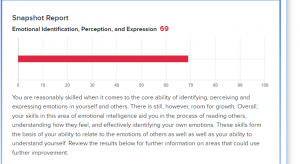
https://psychologytoday.tests.psychtests.com/bin/transfer
This is my emotional intelligence score from a free test I took on Psychology Today.
References
Baron, R. A., & Branscombe, N. R. (2017). Social psychology (14th ed.). Pearson.
Weekly Blog 6
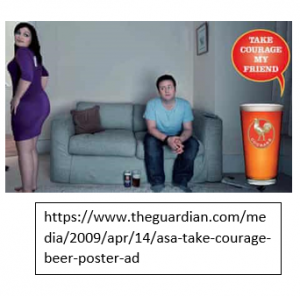
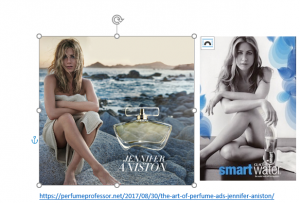
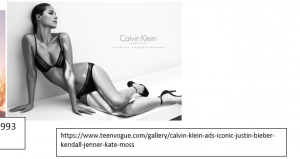
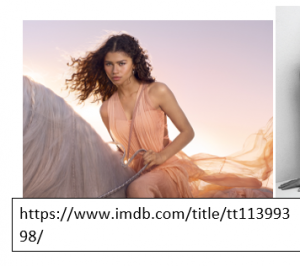
I had known about how ads often sexualize women or portray them as vulnerable, submissive, or like objects. However, I did not know the extent to which ads sometimes went, as Jean Kilbourne demonstrated in her presentation. Many of the ads were extremely graphic and suggestive, and incredibly demeaning. I am not sure were even effective advertising considering the controversy many of them would generate for the company. This video helped me to understand the sheer scale of the demeaning techniques ads will go to to sell their products, and the effects it has on women. I also learned that infants as young as six months can recognize corporate logos, indicating that advertising is extremely influential.
From left to right on my images, I chose a beer ad, two Jennifer Anniston ads for perfume and water, a Calvin Klein ad, and a perfume ad featuring Zendaya, which I talked about in my last blog. In each of these ads, there is some form of sexualization or demeaning of women. In the first ad, the beer is represented as offering courage to either approach women or to criticize their body, as the ad company indicated in the article that the ad was designed around the concept of being brave enough to tell a women she looks bad in a dress, but could be interpreted in other ways (Plunkett, 2009). In the next two ads, Jennifer Anniston poses nude for both a perfume company and lifewater. I found these ads to be objectifying of the female body, especially the lifewater ad as bottled water is about as disconnected from sex as I can imagine.
The Calvin Klein ad I chose because it both objectifies the model and puts her in a submissive or infantile position, something that Kilbourne noted in her video. Finally, I chose the Zendaya perfume ad because she is objectified in the ad, and portrayed in a revealing dress. I wrote in my previous entry about how unneccessary and unrelated this is to the actual perfume itself.
I chose all of these ads because they objectify women in various ways. Some portray women as an object of ridicule, others portray women as sex objects, even when selling products unrelated to sex. Others treat women as submissive and infantile objects. They are all examples of the way advertisers objectify and demean women to sell their products.
References
Plunkett, J. (2009, April 15). “Take Courage” beer ad banned. The Guardian. https://www.theguardian.com/media/2009/apr/14/asa-take-courage-beer-poster-ad
Weekly Blog 5



The images above are the ads I chose for this blog. The first one is A, the second to the right is B, and the third ad on the bottom is C.
The first ad, Picture A, is a car ad from Ford. It represents a credible source (or at least appears to). The ad is for their new taurus model. The main selling point in the advertisement is safety, and to reinforce this, the ad talks about how the car has been rated the safest full size car for sale in the country. To support these claims, they use data from the National Highway Traffic Safety Administration, which is a government organization. It attempts to establish credibility by using an outside source funded by the government to study highway safety in a nonbiased way. Credibility has been proven increase the effectiveness of persuasion (Baron & Branscombe, 2017). One of the methods to increase perceived credibility is to use testimony from unbiased experts (Baron & Branscombe, 2017). To me, this ad is the most effective because it uses data from a (presumably) unbiased source to back up its claims, and its claims are of significant important to many people.
The second ad, picture B, is an example of a noncredible ad. In this ad, CarMax is advertising their online car ordering service, and uses a llama appearing to drive the vehicle to represent that anyone can do it. This ad uses no sources whatsoever to verify any claims, and the ad avoids mentioning facts or statistics, instead trying to sell you on the premise that anyone can do it. Because there are no data or sources in the ad, no experts giving testimony, no factual claims being made or cited, and it relies purely on an entertaining gimmick, it would be regarded as non credible (Baron & Branscombe, 2017).
I would argue that the ad in Picture B is attempting to rely on both the Electronic Word of Mouth phenomenon and the heuristic processing model to sell its product. The electronic word of mouth phenomenon is simply that when ads spread online, particularly if they go viral or are spread among friend groups, they are more effective (Baron & Branscombe, 2017). In this case, the use of a rediculous premise and funny visual gags is to try and make the ad go viral, which will increase its popularity (Baron & Branscombe, 2017). In addition, the ad is very fast paced, funny, and doesnt go into the technical details or comparisons to other services. Because of this, the ad relies on the heuristic processing model, or the peripheral route to persuasion, which states that persuasive techniques that the audience isnt too invested in and make them feel good are often effective (Baron & Branscombe, 2017). This is because it acts like a mental shortcut in the brain, preventing the audience from carefully scrutinizing it by instead making it fast and flashy (Baron & Branscombe, 2017).
The third ad, Picture C, is an example of an attractive source. An attractive person in an ad is used to more effectively market the product (Baron & Branscombe, 2017). In this example, the ad features zendaya on a horse, and is selling perfume. Attractive people or celebrities in ads are more effective at persuasion (Baron & Branscombe, 2017). In this case, they use Zendaya, a well known movie star and model. I do not regard this ad as particularly effective. I would find it more compelling if it instead focused on the product itself: what it smells like, how long it lasts, and what occasions it would be good for. These are actual, relevant details that would want to know if I were deciding on a cologne or perfume. I find those details to be far more persuasive than a model frolicking on a beach with a horse.
References
Baron, R. A., & Branscombe, N. R. (2017). Social psychology (14th ed.). Pearson.
Weekly Blog 4
When reviewing my test answers, I was happy to find that I got most answers correct. For the answers that I got incorrect, I was able to find the correct answer for several of them through researching terms and whatnot, but one answer I was not able to find a correct answer for. This was dissapointing, but I suppose it was a very situational question. What I did to improve my knowledge for next time was to modify my original notes with the new information I had learned from my answers. I changed some information for self-control, heuristics, and social comparisons. I feel that this new information will prove useful in the future, and now I know to prepare more for situational questions rather than more dictionary definition types. I need to know how to take a situation and assess how to look for class concepts and define them.
For my picture, I have included a simple example of my simplified study notes.

Weekly Blog 3
I have had a few friends who had both similar and different music tastes than I did. I will say that the people I considered closer friends coincidently had music tastes much closer to mine, even though music was not something we regularly discussed. We did happen to share many values, even though he is the opposite political party as I am. We tended to agree on shows we liked, concepts, philosophy on various topics etc.
I do not regularly listen to music, nor do I follow bands or music trends etc. Because of this, I do not regularly associate music with most people in my life. There are a few exceptions. I associate my dad with Creedence Clearwater Rivival and their music, because he would often listen to their songs when we took road trips. In addition, one of his nicknames for my mom is based on one of their songs “Suzie Q.” I associate several songs with my friend I mentioned earlier, because he would frequently introduce me to new types of music and songs, which I ended up greatly enjoying. For example, one song that he enjoyed listening to was “New Flesh” by the Current Joys.

Image credit: google.com
This image is one of the songs that I associate the most with him. I dont have a recent accompanying picture of him, as he moved away some time ago, and I don’t want to embarass him by using a very old picture. But this was one of the songs he introduced me to, and when I encounter it, it reminds me of him and our adventures together.
Weekly Blog 2
Student Reflection
I would characterize myself as a good student, but not the ideal perfect, hardworking college student. While I am able to do the work I have been tasked with (so far), I do not feel that I would be capable of some of the more intense assignments offered in various majors here at ODU. I feel that I would be incapable of handling the sheer amount of studying, practice, and group work that some disciplines may require. While I have good grades and everything now, I don’t take it for granted.
In fact, this lack of confidence in my abilities as a college student had a huge influence on deciding my major. A huge part of my ability to attend college right now is because of my scholarships, and if I decided to persue a major that was very difficult, I feared that I would fail and my GPA-dependent scholarships would be gone, causing me to take out loans and perhaps even having to drop out if I wasnt capable enough to push through.
Because of that, I avoided majors that required heavy math work because I have always struggled with it. Sadly, this meant missing out on potentially interesting majors such as cybersecurity, computer science, and mechanical engineering. I am interested in these majors and careers in those fields, but I cannot risk losing my scholarships and sinking so much money into something I might not be capable of doing. I had to choose a major that I was interested in but was also (maybe) capable of achieving.
To improve my confidence as a student, I would have needed to interact with others in the program and determine if I was capable of the harder math classes in those majors. I would also need to attend constant math tutoring, potentially quit my job to have more time for those classes, and study late into the night. With COVID and the demand for money to pay my expenses, these options were not feasible, but could have given me a chance to persue those programs. To increase my confidence now, I could try to associate with other students and study with them, which could aid my retention and ability to employ textbook concepts.
Self Efficacy
My Self-Efficacy results were 30/40, or a 3. According to our prompt the average is around 29 or 2.9. I am not sure that my 1 point over this is significant enough to say my self-efficacy is above average, but I might be slightly higher than average. I found this result somewhat unsurprising, assuming a three is about average. I am capable of setting goals and getting them done, and consider all the options and potentials when setting a goal. Because of this, I find that I am able to get things done when I want to. I have accomplished complicated adventures and trips, and completed difficult writing assignments in the past through careful planning and execution.
Graduation Day

This is my at my high school graduation. I chose it to represent my past academic accomplishments, and the hope for more in the future.
Weekly Blog 1
Course Objectives
Outline the procedures social psychologists use to test hypotheses about the behavior of individuals and of groups I think this will strengthen my understanding of the scienctific method and its use in psychology. I am fairly familiar with it already from several other classes, but understand that reinforcing it is always a good idea.
Discuss the processes through which people perceive and attempt to understand others.
This is an extremely important topic, one which will inform how I interact with others. Perhaps more importantly, an understanding of these processes allows me to better prepare and handle myself in social situations such as job interviews, making a tough decision, in a relationship, etc.
Explain how attitudes are formed and changed, and how they are related to behavior.
Attitudes are something that determine a persons responsiveness, their first impressions, and their outlook on numerous issues. Understanding their formation and changes will help in situations such as politics, where the ability to understand another person’s perspective becomes extremely important when trying to reach a compromise.
Discuss the origins and effects of prejudice and discrimination.
This is another important point. I already know from a previous sociology class the effects of prejudice and discrimination, however I don’t understand the psychological origins of it. I am interested in learning of those origins and hope it will further my open mindedness to others.
Discuss the factors that influence our liking for other individuals and that lead to the
formation of close relationships.
I hope to learn more about this because I would like to make friends to join me on adventures and activities. I also feel that closer relationships could give me something positive to look forward to and new perspectives in life. This is beneficial for any relationship building, whether personal or at work.
To be able to make connections, or integrate learning, between courses and to outside
experiences.
This is something that I am already doing, but it is very important and makes the class feel like a real thing, not just a theory or textbook chapter. I can say that I have already experienced this when doing my heuristics assignment; I was able to connect one of the heuristics to my life because I used it when trying to start exercising. Being able to take classroom concepts and apply them to the real world is incredible because it shows you so much more about the world around you and why it is the way that it is.
Expectations
Like stated in the paragraph above, my goal for this course is to take the concepts we discuss and use them to understand the world around me. I have benefited from this previously in a sociology course, where I was able to take the concepts I learned and apply them to real world politics and strategy, and it suddenly gave me an entirely new view on everything. I hope that this class does the same, and I am better able to understand the world around me.
Strategies
My main goal for this course is effective time management. By setting aside specific days and times every week for this course, I aim to stay on top of my work and get it done in time every week. I had some difficulty understanding the syllabus, but through some note-taking am now able to understand my expected assignments.
Notes/Image
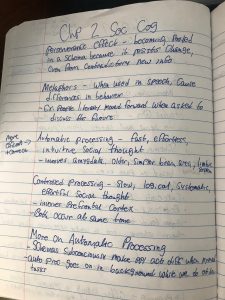
Here are some of my notes for these first chapters.